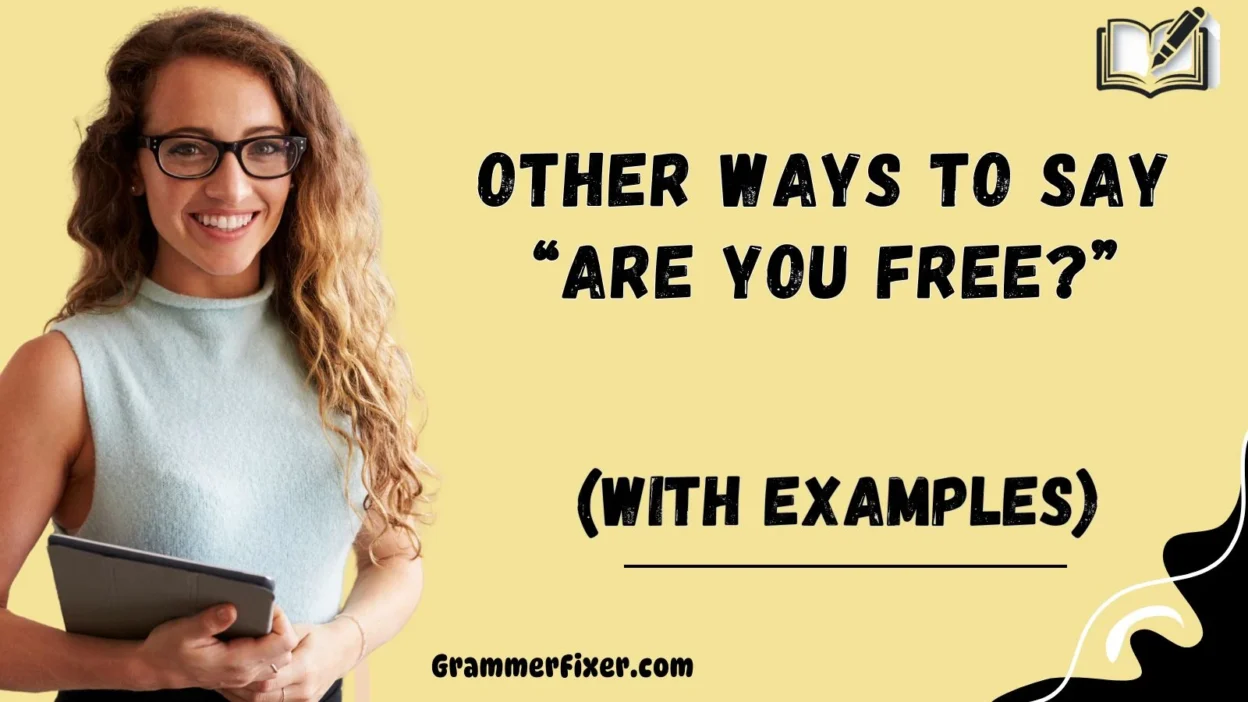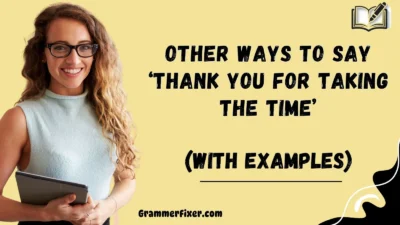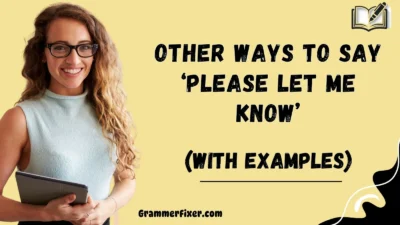Finding the right way to ask “Are you free?” can make your communication feel more thoughtful, respectful, and personal. Whether you’re scheduling a meeting, inviting someone to connect, or checking availability, the words you choose show how much you value the other person’s time.
The following alternatives will help you express your message with warmth, care, and professionalism, ensuring your intent is always clear and considerate.
What Does “Are You Free?” Mean?
“Are you free?” is a simple and polite way of asking whether someone is available at a particular time for a meeting, call, or chat. It’s commonly used in both personal and professional contexts to check availability or openness without demanding an immediate commitment.
When to Use “Are You Free?”
You can use “Are you free?” when you want to know if someone has time to talk, meet, or collaborate. It’s most suitable in situations like:
- Scheduling a quick catch-up or discussion
- Checking before sending a meeting invite
- Inviting someone to a casual or formal chat
It’s ideal when your relationship with the recipient is friendly or collegial and you want to sound approachable yet respectful.
Is It Professional/Polite to Say “Are You Free?”
Yes — “Are you free?” is generally polite and professional, especially when paired with context like “this afternoon” or “for a quick call.” However, it can sound a bit too casual in very formal settings, so it’s best to tailor your tone depending on your audience.
For example, saying “Do you have a moment to discuss…” or “Would you be available…” can feel more polished in professional emails.
Pros or Cons
Pros:
- Friendly, direct, and easy to understand
- Works well in both casual and semi-formal conversations
- Encourages collaboration and openness
Cons:
- Can feel too casual in corporate or client communication
- Lacks context if you don’t specify when or why
1. Are You Available?
Meaning: A polite, professional way to ask if someone has time.
Detailed Explanation: This phrase is slightly more formal than “Are you free?” and works well in both business and personal contexts.
Scenario Example:
“Hi Sarah, are you available for a quick chat about the proposal this afternoon?”
Best Use: In work emails, meetings, or client outreach.
Worst Use: In overly casual settings—it might sound stiff.
Why It Works: It shows respect for the person’s time.
Tone: Professional and courteous.
2. Do You Have a Moment?
Meaning: A gentle way to ask for brief attention or time.
Detailed Explanation: Suggests you value their time and only need a minute.
Scenario Example:
“Hey Alex, do you have a moment to discuss the report edits?”
Best Use: For brief work matters.
Worst Use: When requesting long or complex discussions.
Why It Works: Sounds respectful and considerate.
Tone: Warm and polite.
3. Would You Be Available?
Meaning: A more formal variation of “Are you free?”
Detailed Explanation: Ideal for professional settings like client or managerial communication.
Scenario Example:
“Would you be available for a follow-up call on Wednesday?”
Best Use: Business meetings or formal invitations.
Worst Use: Informal chats.
Why It Works: Adds professionalism and courtesy.
Tone: Formal and respectful.
4. Can We Schedule a Time to Talk?
Meaning: Suggests coordination and mutual convenience.
Detailed Explanation: Implies flexibility and respect for the other person’s calendar.
Scenario Example:
“Can we schedule a time to talk about the design changes?”
Best Use: When planning discussions that need scheduling.
Worst Use: For spontaneous or brief chats.
Why It Works: Professional and considerate.
Tone: Cooperative and thoughtful.
5. When’s a Good Time for You?
Meaning: You’re asking them to choose a convenient time.
Detailed Explanation: Shows flexibility and prioritizes their availability.
Scenario Example:
“When’s a good time for you to review the presentation?”
Best Use: Client or team collaboration.
Worst Use: When you need an immediate answer.
Why It Works: Empathetic and flexible.
Tone: Friendly and accommodating.
6. Do You Have Time to Chat?
Meaning: A casual yet respectful way to ask for a conversation.
Detailed Explanation: Common in workplaces with informal culture.
Scenario Example:
“Do you have time to chat about next week’s event?”
Best Use: Between coworkers or peers.
Worst Use: In formal or client-facing communication.
Why It Works: Friendly and approachable.
Tone: Warm and casual.
7. Would Now Be a Good Time?
Meaning: Checks immediate availability politely.
Detailed Explanation: Helpful when you’re about to start a conversation but want to ensure timing is right.
Scenario Example:
“Would now be a good time to go over the details?”
Best Use: Real-time chats or quick follow-ups.
Worst Use: For scheduling future events.
Why It Works: Shows real-time courtesy.
Tone: Polite and considerate.
8. Are You Around?
Meaning: Informal way to ask if someone’s present or available.
Detailed Explanation: Used in friendly or casual professional communication.
Scenario Example:
“Hey, are you around to look at the draft together?”
Best Use: With teammates or colleagues you know well.
Worst Use: Client emails.
Why It Works: Builds friendly rapport.
Tone: Casual and approachable.
9. Is This a Good Time to Talk?
Meaning: Confirms availability before continuing a conversation.
Detailed Explanation: Respectfully asks if they can talk now.
Scenario Example:
“Hi, is this a good time to talk about the updates?”
Best Use: Calls, live chats, or real-time follow-ups.
Worst Use: Emails about scheduling future meetings.
Why It Works: Shows respect for boundaries.
Tone: Thoughtful and polite.
10. Can I Borrow a Few Minutes?
Meaning: A kind way to request someone’s time.
Detailed Explanation: Emphasizes brevity and politeness.
Scenario Example:
“Can I borrow a few minutes to discuss the client brief?”
Best Use: In workplace conversations or quick requests.
Worst Use: For lengthy discussions.
Why It Works: Humble and courteous.
Tone: Respectful and friendly.
11. Are You Open for a Quick Discussion?
Meaning: Invites dialogue while acknowledging their choice.
Detailed Explanation: Suggests respect and consent for engagement.
Scenario Example:
“Are you open for a quick discussion on the budget changes?”
Best Use: In team collaborations.
Worst Use: When the topic is urgent or non-optional.
Why It Works: Inviting and non-imposing.
Tone: Polite and diplomatic.
12. Can We Catch Up?
Meaning: Suggests a friendly or professional conversation.
Detailed Explanation: Works for both social and work-related follow-ups.
Scenario Example:
“Can we catch up this week to finalize the plan?”
Best Use: Between colleagues or old contacts.
Worst Use: In formal business contexts.
Why It Works: Builds connection and goodwill.
Tone: Friendly and positive.
13. May I Have a Moment of Your Time?
Meaning: A courteous and respectful request.
Detailed Explanation: Slightly old-fashioned but very polite.
Scenario Example:
“May I have a moment of your time to review the proposal?”
Best Use: With managers or clients.
Worst Use: Casual settings.
Why It Works: Very respectful and formal.
Tone: Polite and traditional.
14. Would You Mind If We Spoke Briefly?
Meaning: Shows care for their consent and time.
Detailed Explanation: Makes your request sound humble and thoughtful.
Scenario Example:
“Would you mind if we spoke briefly about your feedback?”
Best Use: When you’re making a delicate request.
Worst Use: When time is critical.
Why It Works: Respectful and empathetic.
Tone: Gentle and courteous.
15. Are You Available for a Quick Call?
Meaning: Specifies communication type.
Detailed Explanation: Clear and professional for scheduling phone or Zoom calls.
Scenario Example:
“Are you available for a quick call this afternoon?”
Best Use: Business or team communication.
Worst Use: For in-person meetups.
Why It Works: Direct yet polite.
Tone: Professional and efficient.
16. Could We Find a Time to Connect?
Meaning: Suggests arranging a mutually convenient moment to meet or talk.
Detailed Explanation: Shows flexibility and prioritizes mutual convenience rather than urgency.
Scenario Example:
“Could we find a time to connect later this week to discuss next steps?”
Best Use: Client or partner communications.
Worst Use: Informal conversations.
Why It Works: Sounds accommodating and cooperative.
Tone: Professional and collaborative.
17. When Might You Have a Few Minutes?
Meaning: A softer, time-conscious alternative to “Are you free?”
Detailed Explanation: Suggests respect for the other person’s schedule by letting them choose the time.
Scenario Example:
“When might you have a few minutes to go over the draft?”
Best Use: For managers, clients, or anyone with a busy schedule.
Worst Use: Casual internal chats.
Why It Works: Respectful and empathetic.
Tone: Polite and flexible.
18. Can We Touch Base?
Meaning: A business-friendly phrase meaning “Can we reconnect or discuss briefly?”
Detailed Explanation: Common in professional communication to check progress or updates.
Scenario Example:
“Can we touch base on the new marketing plan tomorrow?”
Best Use: Workplace and client conversations.
Worst Use: Personal or informal contexts.
Why It Works: Efficient and businesslike.
Tone: Professional and direct.
19. Do You Have a Few Minutes to Spare?
Meaning: A friendly way to ask if someone can offer a bit of time.
Detailed Explanation: Sounds humble and considerate.
Scenario Example:
“Do you have a few minutes to spare to review the figures?”
Best Use: Everyday professional settings.
Worst Use: When the matter needs lengthy discussion.
Why It Works: Polite and time-aware.
Tone: Friendly and respectful.
20. Could I Have a Bit of Your Time?
Meaning: A humble, polite request for attention or help.
Detailed Explanation: Great for sensitive or formal interactions.
Scenario Example:
“Could I have a bit of your time to go over the design proposal?”
Best Use: For requests directed at superiors or clients.
Worst Use: Casual conversations.
Why It Works: Gentle and respectful.
Tone: Courteous and formal.
21. Are You Free to Meet?
Meaning: A clear, direct way to check for in-person or virtual availability.
Detailed Explanation: Keeps the meaning simple while maintaining professionalism.
Scenario Example:
“Are you free to meet on Thursday morning?”
Best Use: Scheduling meetings.
Worst Use: When context is unclear.
Why It Works: Straightforward and professional.
Tone: Direct yet polite.
22. Can We Find a Minute to Talk?
Meaning: Suggests squeezing in a quick discussion.
Detailed Explanation: Often used between colleagues with established rapport.
Scenario Example:
“Can we find a minute to talk before the presentation?”
Best Use: Team discussions or updates.
Worst Use: With clients or new contacts.
Why It Works: Feels natural and approachable.
Tone: Friendly and conversational.
23. Would You Happen to Have a Moment?
Meaning: A very polite, almost deferential way to ask.
Detailed Explanation: Adds warmth and respect to the request.
Scenario Example:
“Would you happen to have a moment to look over this document?”
Best Use: With clients, leaders, or anyone you want to impress.
Worst Use: Very casual contexts.
Why It Works: Gracious and refined.
Tone: Polite and formal.
24. Do You Have a Second?
Meaning: Casual shorthand for “Are you free for a quick moment?”
Detailed Explanation: Common in friendly workplaces and real-time conversations.
Scenario Example:
“Hey, do you have a second to check this file?”
Best Use: Among peers or coworkers.
Worst Use: Formal or written communications.
Why It Works: Light and efficient.
Tone: Casual and quick.
25. Can I Check Something With You?
Meaning: Suggests collaboration or seeking feedback.
Detailed Explanation: Implies you value their input and need a moment of their time.
Scenario Example:
“Can I check something with you before sending it to the client?”
Best Use: Work discussions, feedback sessions.
Worst Use: For purely social interactions.
Why It Works: Team-oriented and cooperative.
Tone: Friendly and inclusive.
26. Is This a Good Time to Reach Out?
Meaning: Ensures your timing is considerate before engaging.
Detailed Explanation: Great for emails or messages that might interrupt.
Scenario Example:
“Hi Maria, is this a good time to reach out about the next steps?”
Best Use: Initial or follow-up outreach.
Worst Use: Real-time chats where immediacy is needed.
Why It Works: Respectful of time and boundaries.
Tone: Thoughtful and polite.
27. Are You Open to a Quick Meeting?
Meaning: Invites participation without pressure.
Detailed Explanation: Implies respect for the other person’s willingness and schedule.
Scenario Example:
“Are you open to a quick meeting later today?”
Best Use: Internal coordination or collaborative projects.
Worst Use: With new clients—it may sound too casual.
Why It Works: Inviting and flexible.
Tone: Warm and professional.
28. Could We Have a Quick Word?
Meaning: A traditional and polite way to ask for a private chat.
Detailed Explanation: Works in both formal and informal contexts.
Scenario Example:
“Could we have a quick word about tomorrow’s agenda?”
Best Use: When discussing something discreetly.
Worst Use: Written or digital conversations.
Why It Works: Brief yet polite.
Tone: Professional and composed.
29. When Would Be a Good Time for You?
Meaning: Asks for their preferred time directly.
Detailed Explanation: Centers their convenience, showing respect.
Scenario Example:
“When would be a good time for you to go over the slides?”
Best Use: When scheduling important discussions.
Worst Use: For immediate or unplanned talks.
Why It Works: Empathetic and flexible.
Tone: Respectful and diplomatic.
30. What Time Works Best for You?
Meaning: Offers full control to the other person.
Detailed Explanation: A thoughtful way to accommodate their schedule.
Scenario Example:
“What time works best for you to discuss next quarter’s goals?”
Best Use: Client meetings, collaborative projects.
Worst Use: When urgency is required.
Why It Works: Shows respect and flexibility.
Tone: Professional and warm.
Conclusion
Choosing the right words matters more than we often realize. Replacing “Are you free?” with a more thoughtful or tailored phrase shows respect, emotional intelligence, and consideration for the other person’s time and comfort. Whether you’re writing a professional email or having a friendly chat, using alternatives like “Would you be available?” or “When’s a good time for you?” can make your communication sound more polished, kind, and human.
In professional relationships, it’s the small details — tone, timing, and phrasing — that make people feel valued. So next time, instead of just asking “Are you free?”, choose the words that best reflect your intent, warmth, and respect.



